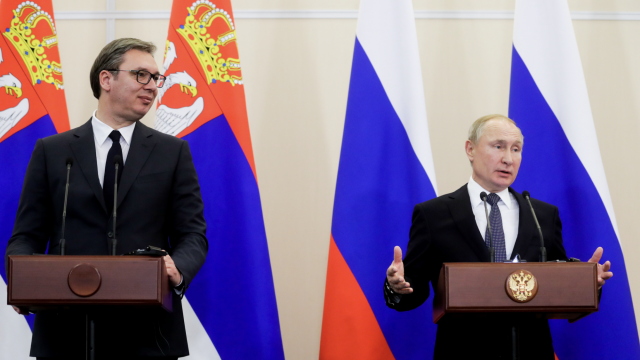LONDON — Russian banks could step up issuance of subordinated debt following a recent revision of new Basel III guidelines that gives lenders greater flexibility in meeting their regulatory capital requirements.
The new proposals could spur some of Russia's largest banks to sell Tier 1 debt that is fully compliant with the Basel III requirements, while smaller or better capitalized lenders are expected to be more active in Tier 2 issuance.
"The proposed changes are definitely a positive for new issuance," said Kapil Damani, senior capital structurer at BNP Paribas.
The Central Bank's proposed new amendments would lower banks' minimum Tier 1 capital requirements, cut the cost of issuing perpetual bonds and allow lenders more room to boost their total capital ratio by issuing new-style Tier 2 debt.
Banks will also get more time to comply with the new rules, as the mandatory switch to the new framework will only become effective on January 1, 2014, three months later than expected.
Cheaper Tier 1
Issuing Basel-III compliant Tier 1 debt would become less onerous than previously thought, a change that could push more issuers to embrace the instrument, which is so far largely untested in Russia.
The new guidelines lower the loss-absorption trigger for Tier 1 bonds — the ratio of the bank's core capital below that holders of the bonds would be forced to bear losses — to 5.5 percent from the initial proposition of 6.4 percent.
"Prior to the change, Russian issuers would have had to pay up to issue Tier 1," Damani said. "Now, they have a larger buffer between their common equity Tier 1 ratios and the trigger point, which will be helpful to place Tier 1 efficiently."
"Before, Tier 1 was not on the table for some issuers. Now it is a credible alternative," he added. "I imagine issuers will spend some time analyzing whether it is feasible rather than ignore it."
Issuing Tier 1 debt, however, is not an option for every lender, analysts say.
"Only the largest and strongest Russian banks are capable of issuing Tier 1 capital securities at a non-prohibitive cost given that the likelihood of hitting the write-down trigger point is still quite meaningful," said Dmitry Poliakov, senior credit analyst at Sberbank Investment Research.
Some also point out that another of the proposed changes, which cuts the minimum Tier 1 ratios banks are required to hold, could reduce the need for the better capitalized names to raise Tier 1 capital in the first place.
According to the new rules, the minimum Tier 1 ratio banks are required to hold will be lowered to 5.5 percent from the initial proposition of 7.5 percent. It will increase to 6 percent in 2015.
The requirement on the more restrictive core Tier 1 ratio, which comprises only capital of the highest quality, will also be lowered, to 5 percent from the 5.6 percent initially planned.
Tier 2 Oversupply?
In spite of lower requirements for Tier 1, banks will continue to be required to keep their total capital ratio, including both Tier 1 and Tier 2 debt, at a minimum of 10 percent.
Lenders could therefore be tempted to rely more heavily on Tier 2 debt to meet this ratio.
"We expect intense Tier 2 issuance over the coming months," said an origination official who covers the country at a European bank. "Some issuers could look at Tier 1 out of necessity, but otherwise Tier 2 will be their most preferred option."
A number of Russian issuers have already printed potentially Basel III-compliant Tier 2 bonds this year, including Credit Bank of Moscow, Sberbank, Ural Bank for Reconstruction and Development and Russian Standard Bank for a combined total of $1.8 billion.
While investors seem to have become comfortable with the loss-absorption features these new bonds incorporate, some caution that the boundaries of the market remain untested.
"Banks will be tempted to flood the market with relatively inexpensive contingent capital [Tier 2] instruments that could eventually add cost pressure if such supply could not be absorbed by the market," Poliakov said.
Mikhail Nikitin, a credit analyst at VTB Capital, has similar concerns. "Potential supply in new-style Tier 2 bank debt might result in repricing for the whole segment, with the most likely outcome an increase in sub and senior ratios for new-style Tier 2, at least for sub-investment grade names," he wrote in a recent note.
While the rush to issue Tier 2 debt could be somewhat mitigated by a new amendment that would make the phasing out of old-style Tier 2 securities from banks' capital more gradual than previously thought, bankers remain upbeat on Tier 2 issuance.
According to the latest proposal, old-style subordinated debt will be phased out from the calculation of banks' capital using a portfolio approach rather than on an instrument-by-instrument basis, allowing banks to maximize the capital treatment of their existing subordinated securities and benefit from higher regulatory capital during the transition.
Investors waiting to get hold of more subordinated bonds from the country could also have some reason to cheer.
One of the most obscure features of new-style Tier 2 bonds issued recently — the possibility of a write-down or a conversion into equity being triggered if Russia's Deposit Insurance Agency (DIA) takes bankruptcy prevention measures on a lender — might become less of a concern in the near future.
According to a number of market participants, the provision that assigns these powers to the DIA is due to expire at the end of 2014. "While I haven't seen any legal opinions on this, my understanding is that when the law expires it will not be renewed," one observer said.
The fact that the CBR could ask the DIA to step in has so far perplexed some investors, who see this trigger as a lot more subjective compared to a hard-figure threshold.
The provision has cost some issuers of new-style Tier 2 as much as 100bp in additional risk premium demanded by investors.
According to bankers, however, investors will assess the risk of DIA intervention on an issuer-by-issuer basis.
"A scenario in which the agency would take bankruptcy protection measures on an issuer like Sberbank, for example, is quite remote," said Neil Slee, executive director at Goldman Sachs. "Smaller banks have obviously bigger question marks and hence will require a much larger premium to access the market."
A Message from The Moscow Times:
Dear readers,
We are facing unprecedented challenges. Russia's Prosecutor General's Office has designated The Moscow Times as an "undesirable" organization, criminalizing our work and putting our staff at risk of prosecution. This follows our earlier unjust labeling as a "foreign agent."
These actions are direct attempts to silence independent journalism in Russia. The authorities claim our work "discredits the decisions of the Russian leadership." We see things differently: we strive to provide accurate, unbiased reporting on Russia.
We, the journalists of The Moscow Times, refuse to be silenced. But to continue our work, we need your help.
Your support, no matter how small, makes a world of difference. If you can, please support us monthly starting from just $2. It's quick to set up, and every contribution makes a significant impact.
By supporting The Moscow Times, you're defending open, independent journalism in the face of repression. Thank you for standing with us.
Remind me later.






